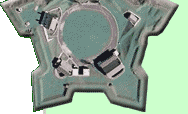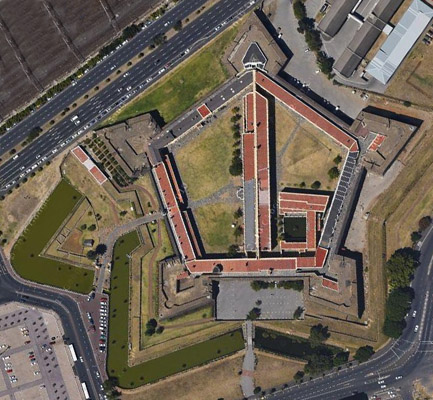
 |
 |
Castle of Good Hope Cape Town, South Africa |
 |
 |
 |
 |
|||||
 |
|||||||
 |
Once the British had decided they didn't want the lower end of Africa for themselves, the Dutch East India Company sent Jan Van Riebeek (1619-1677), along with 82 men and 8 women, to what is now Cape Town. Jan and his troops set about establishing a waypoint for Dutch East India Company vessels en route from the Netherlands to the East Indies, now Indonesia, by building the Fort de Goede Hoop out of clay and timber. By the 1660's tensions between the Netherlands and Britain, on their way towards the Second Anglo-Dutch War (1665-1667) over trade rights, were a-boilin'. Fort de Goede Hoop was replaced by the current fortress, whose stones were imported from the Netherlands. Work commenced in 1662 and proceeded over the next thirty years. On January 8 1806 the British defeated the Dutch at the Battle of Blaauwberg, a small sideshow in the raging Napoleanic Wars (1803-1815). As part of the Articles of Capitulation that the defeated Dutch signed on January 10 1806, Cape Town and the Castle of Good Hope became property of the British Empire. By the middle of the 19th century, Britain had expanded into Natal Province. The Zulus took exception to this, but were out-technologized by the end of the 1800's, by which time the British had completely displaced the Dutch as the major colonial influence in the region. The Castle of Good Hope served partially as a prison during the Second Boer War (1899-1902). Fritz Joubert Duquesne (1877-1956), a Boer spy, was imprisoned at the fort in 1901. Though the fort's walls were extremely thick, Duquense dug away at the cement between the blocks night after night with a spoon: He came close to escaping, until a guard found him one morning, unconscious and pinned under a stone that had fallen on him in his tunnel. Slightly squished but unhurt, Duquense would later claim to have sabatoged the armored cruiser HMS Hampshire on which Lord Kitchener (1850-1916) met his end (the Hampshire struck a German mine off the Orkney Islands while taking Kitchener and his staff to Russia and sank on June 5 1916, taking 643 of the 655 souls on board with it). By most accounts, Duquense was full of crap. |
 |
|||||
|
|||||||
 |
|||||||
 |
|||||||
|
|
|||||||
Info Source 1 Info Source 2 Info Source 3
Info Source 4 Info Source 5 Info Source 6 Info Source 7 Info Source 8 Thanks to Google Maps for the image! ©2010 starforts.com |
 |